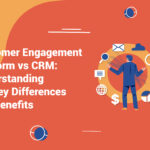As the head of content at an agency that helps companies generate ROI by better understanding their data, I know that truly understanding customers is critical.
I recently embarked on a journey to wrap my head around the concept of a “360-degree customer view”. This journey has taught me that a 360-degree view provides complete insight into every customer touchpoint across the entire lifecycle.
It enables the delivery of personalized experiences. As both a marketer and business leader, I now see the incredible value in unifying customer data and making it accessible across departments.
Let me walk you through my own process of discovery. I’ll define the 360-degree customer view, explain the components, share the benefits I uncovered, and provide tips on how to achieve it based on my research. I encountered some eye-opening concepts and compelling statistics along the way. Stick with me to see how this insight can transform your business too.
Why Customer Understanding Matters
Today’s customers expect personalized experiences. Think about your own consumer habits – you likely read online reviews of products, use self-service options when available, and appreciate customized recommendations. Studies show you’re not alone:
- 85% of shoppers read reviews prior to purchasing [1]
- 60% of consumers have higher customer service expectations post-pandemic [2]
- 59% of IT leaders report the pandemic accelerated their digital transformation efforts [3]
Meanwhile, businesses recognize that customer experience impacts the bottom line. Research reveals:
- 90% of companies say customer experience is a competitive differentiator [4]
- 86% view data visibility across departments as very important [5]
- 73% see a direct link between business performance and customer service [6]
So it’s clear…understanding customers and serving their needs is how brands thrive in this market. The challenge is accessing unified, actionable customer data.
This is where a 360-degree view comes in.
Defining the 360-Degree Customer View
I started my research by simply looking up “what is customer 360” and found surprisingly little consensus on a definition. Many espoused the benefits without clearly conveying what it entails. I had to dig deeper.
Customer 360 refers to a complete, unified view of every customer touchpoint across the entire lifecycle. It requires consolidating data from various channels and systems into one centralized location. This provides visibility into the past, present, and future of a customer’s relationship with your company.
The goal is to gain an accurate, holistic picture of customers to better understand them. These insights enable teams to deliver personalized interactions that meet individuals’ needs and preferences. This is how customer 360 enables remarkable experiences.
The Past, Present, & Future View
A 360-degree customer view provides full visibility into a customer’s unique journey over time. Let’s break down the key components:
The Past View
Seeing the past provides context for where customers are coming from. The historical view displays previous interactions across touchpoints over months or years. For example:
- Website browsing and purchases
- Support tickets opened and resolved
- Product reviews and ratings
- Social media engagement
- Email click-through and open rates
- Event attendance
With this lifetime insight, agents can reference experiences customers have already had. It prevents asking redundant questions or repeating issues.
The Present View
The present view displays real-time data on customers’ current status. This includes details like:
- Contact info and demographics
- Recent transactions and service interactions
- Current open orders or issues
- Existing subscriptions or warranties
Access to present details means agents can address the immediate need without customers having to repeat themselves. It provides quick insight into status changes.
The Future View
Analytics help predict what’s next based on the past and present. By spotting trends and patterns in customer data, you gain a future view. Ask yourself:
- What products might they have interest in next?
- Are they at risk of churning?
- What content or offers would they most appreciate?
Anticipating customer needs is the key to proactive care and relevant cross-sells driving growth.
Now that we’ve defined a 360-degree view and its components, let’s discuss why it matters.
5 Benefits of a Customer 360 View
I initially underestimated the impact a 360-degree customer perspective offers. My research opened my eyes to some compelling benefits:
1. Personalized Service
A complete view of each customer enables hyper-personalized service. With purchase history, preferences, and past issues visible, agents can tailor interactions to individuals. They can offer advice and solutions based on what that particular customer cares about.
2. Proactive Engagement
Spotting trends in the data helps brands anticipate customer needs proactively. For example, seeing a spike in warranty claims could trigger an email campaign about product care. Noticing patterns around service inquiries enables self-help content creation.
3. Increased Loyalty & Retention
Making customers feel valued increases loyalty and retention. 360-degree data empowers brands to surprise and delight customers with relevant offers and recommendations. This VIP treatment makes customers feel known, driving emotional connection.
4. Improved Cross-Sell & Upsell
Similarly, a lifetime view combined with predictive analytics facilitates successful upsells and cross-sells. Brands can align offers to each customer’s demonstrated interests and behaviors, increasing conversion rates.
5. Breaking Down Data Silos
Finally, customer 360 perspective connects disparate data across siloed systems. Linking web, sales, service, and other data provides a “single source of truth” on customers. This unified view empowers departments to align around shared goals.
Clearly this level of customer insight delivers tremendous advantage. So how can we actually achieve a 360-degree perspective?
Tips for Gaining a 360-Degree View
Through my research, I uncovered best practices for gaining complete customer visibility:
Choose a Unified Platform
First, brands need a centralized repository for gathering, storing, and accessing unified data. A customer data platform (CDP) or CRM system like Zendesk is ideal for consolidating information from various channels, applications, and devices onto a single customer record.
Identify Key Data Points
Next, determine what metrics matter most to your business goals, customer journeys, and desired insights. Track details like past purchases, web activity, survey feedback, ticket data, demographics, and more. But focus only on high-value attributes to avoid analysis paralysis.
Enrich Data Over Time
View your 360-degree initiative as an ongoing effort, not a one-time project. Continually expand data breadth and depth from internal systems and external signals like social media. Customer analytics and machine learning can help uncover gaps and opportunities.
Share Insights Company-Wide
The final critical step is democratizing access to unified customer data across the organization – from sales and marketing to service, finance, and beyond. Break down silos that impede delivering personalized experiences.
Conclusion
With the right approach, any brand can gain a 360-degree customer perspective and transform experiences as a result. The examples and statistics I shared prove this view provides unmatched customer insight and business value.
For me, this journey exemplified how even industry “experts” have more to learn. I encourage other marketers and leaders to constantly seek knowledge and truths that challenge your assumptions. A 360-degree view of any topic offers greater clarity and opportunity. Only once we step out of our limited perspectives can we unlock our full potential for customers and companies alike.
I appreciate you joining me on my quest to define 360-degree customer view and convey its power. I welcome your thoughts and questions in the comments below. Let the insight we gain serve both ourselves and others.








